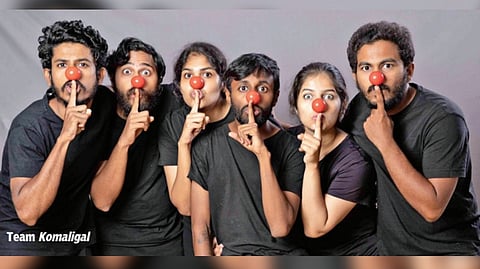

CHENNAI: I was by the seashore and it began raining heavily. I just stood there in awe having my ice cream while looking at a green parrot. 25 years rolled by, but I stood there admiring its beauty. They criticised me for having wasted 25 years of my life and that’s how I became a Komali, but it didn’t matter because to me the green parrot mattered,” says the clown one.
“I saw a pink-coloured man ride a horse and I told everyone about it. They laughed at me and that’s how I became a Komali,” says clown two.
“I had a garden in which I was growing several flowers. I would plant a South red rose and a white rose would grow. People would try to make me feel indifferent, but it didn’t matter because I loved my garden. That’s how I became a Komali,” says clown three.
In the opening act of the play, six clowns have a conversation with each other discussing how they became a Komali (Clown).
Komaligal, directed by Vetri MV, Theatre Akku in association with Quriosity elucidates how women are burdened with the responsibility to shape themselves according to the expectations of the society and at the end of the day, are victims to sexual abuse in different spaces.
Vetri says that the purpose of the conversation was to portray how no matter what we do the society is always going to criticise us and judge us for our choices. He says that the clowns in the play represent people from different walks of life.
“The first clown represents people who are criticised for their passion but continue pursuing it anyway. The second clown represents the dismissal of epics like Ramayana and Mahabharat, and the third clown aims to represent the LGBTQIA+ community. Similarly, the other clowns represent something else,” says Vetri.
The play moves with a butterfly taking these Komalis into its world while offering the Komalis a peek into the lives of several women. “Each character, element and dialogue in the play are handled with utmost precision by our team. For instance, one of the stories in the play deals with caste based violence. The female protagonist of that story is named Meena. This is an homage to Annai Meenambal Sivaraj who gave Periyar the title,” he says.
One of the parts of the play also displays the infamous confession of the rapist Mukesh associated to the Hyderabad Rape case in 2015. The play which deals with factual instances makes it raw for the audience.
Vetri’s vision is to ensure that the audience does not only see the play but also experience it. “A play is an experience. From the time you walk into the theatre, to the time you sit in your seats, to the time you finally watch the play. To complete and perfect this experience for the audience, I wanted the auditorium to smell a certain way and so I called for a particular flavour of incense sticks from Auroville,” he smiles.
The play has elements that can be physically experienced by the audience.
Talking about what inspired him to incorporate this idea into the play, he says, “I attended a play called The Legend of Khasak directed by Deepan Sivaraman. In the play, the characters were making biryani in front of the stage. They actually put the biryani on a plate and served it to the audience in the front row. That was so unusual and was etched in my memory.”
The unique quality of the play is the manipulative set which is rotated and changes the backdrop through every scene. “While I worked at Indianostrum, I had seen our director use a manipulative set. It was innovative and an idea close to home. I also felt that it was not fair for the audience to wait every time we erected or changed sets behind closed screens. So this is a ploy to keep them engaged throughout,” he laughs.
“We are all freshers and new to acting. So at first we got the basics of theatre covered. While perfecting that, we were told that we had to handle manipulative sets on our own. At first we were shocked because we had never heard of it before. We had to undergo 6 months in Devarattam and Kalaripayattu for building core strength. Now with all the training it has become easier,” says Abinaya R, one of the actors of the play.
Talking about the challenges, “I’m a Malayali and I have a thick Malayali accent. I had to make a conscious effort to enunciate each Tamil word properly without making it seem like it is a conscious effort. I finally nailed it!” she smiles.
“Since we are handling the set while a scene is going on, we had to quietly and swiftly prepare the backdrop for the next scene. It was very challenging at first but now with the number of shows and rehearsals we have had it has become relatively easy for us,” says Hariharan, one of the actors of the play.
Other than the extraordinary set design by Joseph Bernard L and Delli Babu, the play has beautiful cinematic light design handled by AK and Viraji.
The troupe which has performed seven shows across the city, aims to take their story to more places and try to tell the story through their Komaligals.
Visit news.dtnext.in to explore our interactive epaper!
Download the DT Next app for more exciting features!
Click here for iOS
Click here for Android